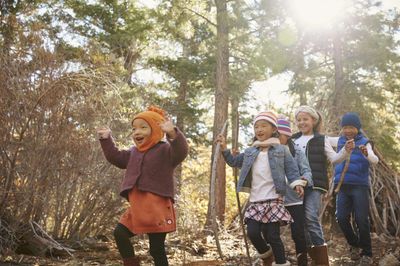Encouraging Nature Play
Children respond to nature like flowers respond to bees. Their world is opened up and further beauty and wonder become apparent while new ideas and ways of looking at things are born. Giving your child this look into nature and all its possibilities is a gift of love and develops an appreciation for the planet that will last well into adulthood. Encouraging nature play starts by involving children in outdoor activities and fostering their natural curiosity. A garden playground for kids hits all the marks and is an activity zone that they can enjoy on a daily basis. Kids like to do projects like planting seeds, building forts and mazes, or helping to create habitat for both wild and domestic animals. Their endless curiosity about everything around them encompasses the wild spaces that are not manipulated and are completely natural. Children get maximum sensory experiences when exposed to nature and their wide eyed take on the outdoors is always individual and unique. Learning how to build a garden playground can help impart a love of this planet along with a sense of ownership and responsibility. It can be something as simple as a small space in the backyard that is turned over to the child to develop in whatever way suits him/her or as a planned space with set activities that utilize the child’s skills and asks them to cultivate the area within a curriculum. Public parks have great programs from which you can draw that emphasize learning and nature in a hands-on manner.
How to Build a Garden Playground
A garden playground is so much more than monkey bars and a slide, although these can be incorporated into the design. A child’s outdoor space is also a classroom and should provide stimuli in the forms of sight, sound, touch, and even taste.
A culinary garden planted and tended by a child allows him/her to see the fruits of their labor and develop an appreciation for where their food comes from and how it is grown. Paths, mazes and special forts open the space to such imaginary places as a pirate’s den or even a princess’ tower. Water features, such as ponds, can hold fish which give the child a sense of responsibility and propriety as they tend to their aquatic friends.
Creating a natural playground can encompass all or just a few of these types of spaces. The key is to allow the child to mold the space into something he or she can enjoy and appreciate. Providing some tools will enhance a garden playground for kids and involve them in garden activities. The first thing you will need is a space. It may be the sand box, a corner of your garden plot, a secret garden in the landscape, or any other outdoor area that can capture the imagination. Next, provide activities and tools. These may be child sized garden implements, a bug catching kit, sketch pads and other art supplies, standard outdoor toys, boxes and crates, and anything that could have a function if applied to the imagination. Ideally, the space should have plenty of seasonal change or the ability to adapt to its user’s wishes. Including vegetation and perhaps animals only enhances the space and amps up the interest level of the space. One of the simpler but more magical ways to create a garden playground is by planting sunflowers. Children can help plant, care for and watch these monstrous plants as they grow. The area then becomes a maze of color and the possibilities for play are endless.
